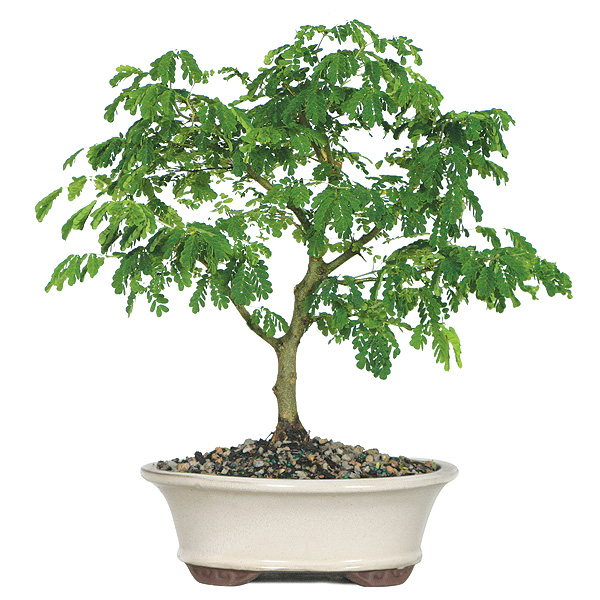
General Background:
The Brazilian rain tree is a hardwood legume that goes by the Latin name Pithecellobium tortum. Like most of its relatives this tree has compound leaves, hard wood and is very spiny. Easy indoor care makes this interesting rainforest tree a great bonsai for beginners.
Trees Features:
The Brazilian Rain Tree has delicate branches featuring tiny light-green compound leaves and spines. The leaves fold up at night or in subdued light and unfolds in the morning light. It has attractive flowers that appear as fragrant white puffy blossoms.
Temperature:
This Bonsai will tolerate temperatures in the upper 30 degree range, but not for a long time and should be brought indoors for the winter. This tree is very adaptable to indoor conditions which are a bonus for bonsai owners living in cooler climates.
Lighting:
Although it grows in full sun in its natural habitat, Brazilian Rain Trees as bonsai seem to appreciate some shade during hottest days of summer.
Watering:
You will need to keep this bonsai specimen evenly moist and ensure that it does not get too dry. Provide humidity with a humidity tray filled with pebbles and take care to ensure that you do not overwater in your attempts to provide enough moisture.
Fertilizing:
You will need to apply a regular weekly feeding program with a balanced liquid fertilizer during the growing season and once a month during cooler weather will keep your Brazilian Rain Tree nourished and healthy.
Pruning / Training:
When Pruning your Bonsai’s branches and twigs be sure to leave a small nub allowing for the possible die-back that often occurs. Many artists choose to avoid the use of a concave cutter on the Brazilian Rain Tree for this reason. Later this can be refined. Once the initial trunk and branch shape is established, the clip-and-grow method is the best way to develop shape in this bonsai. If you do decide to “wire”, it is best to use only nylon strips on green branches, leaving your wire only to tie down branches. Most of the styles used are upright because of the nature of the tree to grow straight when not affected by the winds in their natural habitat.
Insects / Pests:
This Bonsai is quite hearty and as such is mostly pest and disease free. If grown indoors, look for common greenhouse pests and remedy as needed. Many pests can be eliminated with a simple solution of 1tsp. dish soap to 1 quart warm water liberally sprayed on the plant until runoff occurs. Rinse the plant well, and repeat as needed.
Propagation:
Air layering is said to be the best option when propagation is desired. To air layer, cut a small strip of bark away from the desired branch. Wrap the cut area with a small bag filled with moist sphagnum and peat- keep uniformly moist and wait about 6-12 weeks, at which time roots should begin to grow. Take the cutting once it has enough roots to live on its own in a new pot cutting just below the root ball and transplant into a container. Keep the peat/sphagnum mix around the roots when potting and enjoy your new bonsai.
Repotting:
You will want to ensure that you repot your bonsai in the spring in a fast draining soil as too much organic in the soil mix can create wet conditions which causes root rot, fungus and branch die-back. Prune your bonsai’s roots moderately and be sure to avoid fertilization for 4 weeks after transplanting.
Additional Comments:
Take care when working with your Brazilian Rain Tree as this plant is VERY spiny. Rinsing your tree’s leaves free of dust on a regular basis will ensure proper cell growth and keep your tree thriving.
DISCLAIMER: The content provided in this article is not warranted or guaranteed by Bonsai Outlet. The content provided is intended for entertainment and/or educational purposes in order to introduce to the reader key ideas, concepts, and/or product reviews. We are not liable for any negative consequences that may result from implementing any information covered in our articles or tutorials. Happy bonsai gardening.

